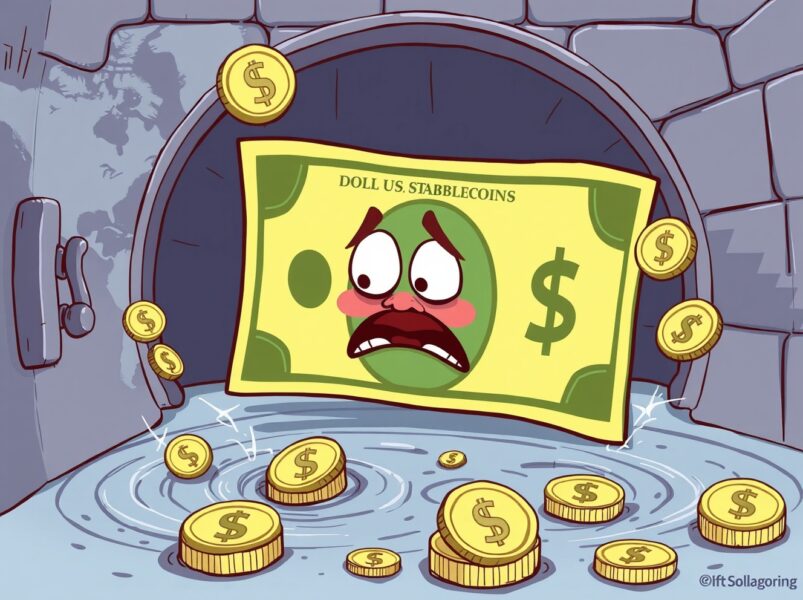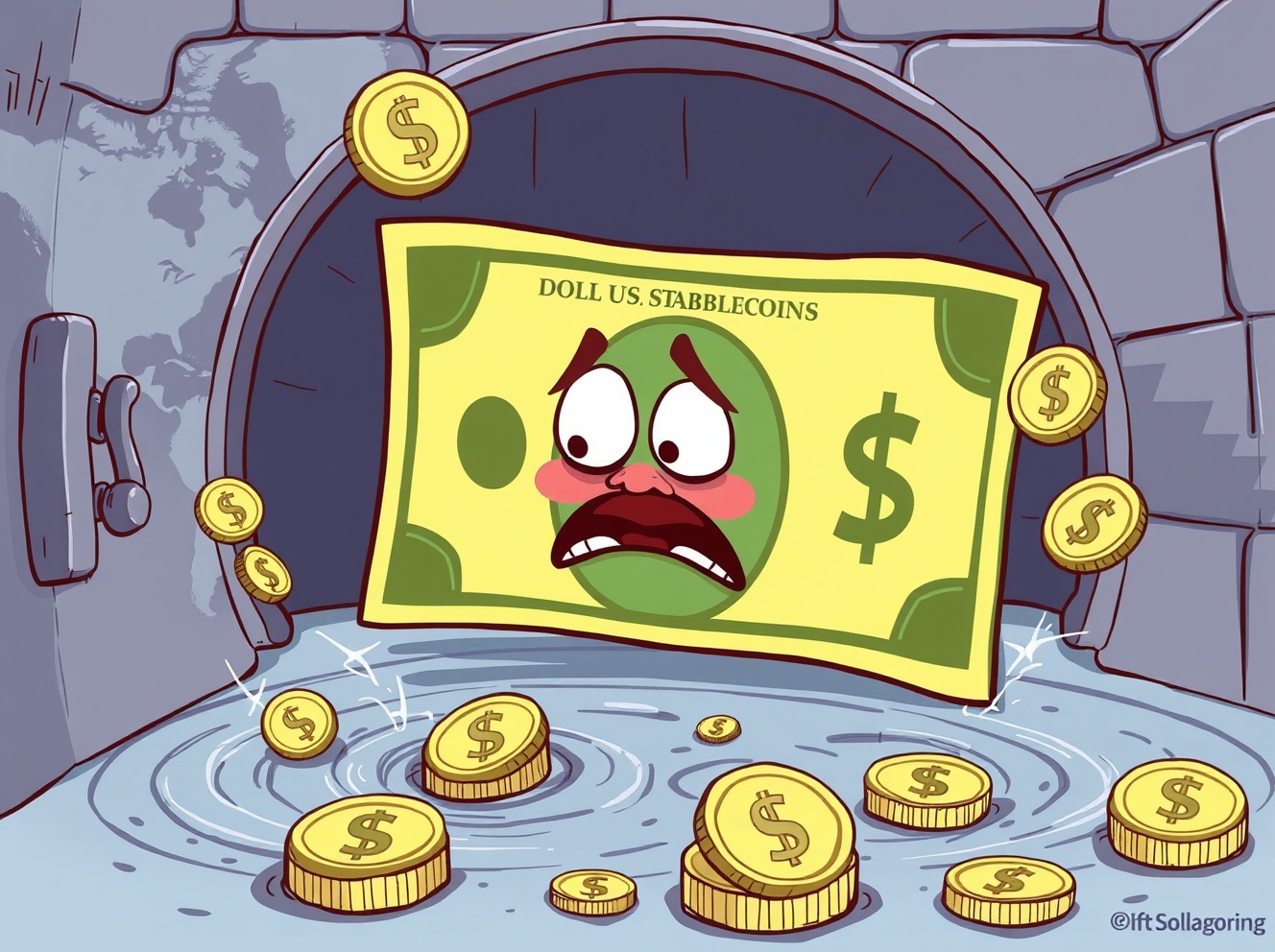Dollar Stablecoins: BOK Issues Crucial Warning on USD’s Safe-Haven Status
0
0

BitcoinWorld

Dollar Stablecoins: BOK Issues Crucial Warning on USD’s Safe-Haven Status
The financial world is abuzz with a significant warning from the Bank of Korea (BOK). While dollar stablecoins often appear as a bridge between traditional finance and the crypto realm, the BOK’s recent assessment suggests they could pose a surprising threat to the U.S. dollar’s long-standing status as a safe-haven asset. This analysis, part of a detailed report on dollar hegemony, urges a closer look at these digital assets.
What Are Dollar Stablecoins and Why Are They Under Scrutiny?
Simply put, dollar stablecoins are cryptocurrencies designed to maintain a stable value, typically pegged 1:1 to the U.S. dollar. They achieve this stability by holding reserves in dollars or dollar-denominated assets. Many see them as a crucial component of the crypto ecosystem, facilitating trading and international remittances.
However, the BOK’s report, released on September 15th, highlights a nuanced perspective. While their widespread adoption in international trade could initially strengthen the dollar’s global footprint, the central bank identifies potential pitfalls that could undermine its stability.
The Double-Edged Nature of Digital Dominance for Dollar Stablecoins
On one hand, the BOK acknowledges that if dollar stablecoins become a primary medium for cross-border transactions, they could indeed reinforce the U.S. dollar’s global dominance. This scenario would mean more demand for dollar-backed assets, further cementing the greenback’s role in the international financial system.
Conversely, the BOK warns of a darker side. The very nature of these digital assets could inadvertently erode the dollar’s coveted safe-haven status. A safe-haven asset is typically a reliable store of value during times of market turbulence, like gold or the U.S. dollar itself. The central bank’s concern stems from the potential for sudden, large-scale movements within the stablecoin market.
How Could Dollar Stablecoins Threaten Financial Stability?
The BOK’s primary concern revolves around the potential for rapid, large-scale withdrawals from dollar stablecoins. Imagine a scenario where a significant portion of stablecoin holders suddenly decide to redeem their digital assets for physical dollars. This could trigger a cascade of effects:
- Mass Redemptions: Stablecoin issuers might be forced to liquidate their underlying dollar-denominated assets, such as U.S. Treasury bonds, very quickly.
- Market Volatility: Such large-scale, forced selling could create significant volatility in government bond markets, disrupting a critical component of global finance.
- Liquidity Crunch: This could lead to a liquidity crunch, where traditional financial institutions struggle to meet their short-term obligations, potentially spilling over into broader markets.
These risks are not merely theoretical. The BOK’s analysis points to the interconnectedness of digital assets and traditional finance, suggesting that shocks originating in the stablecoin market could have far-reaching global ripple effects, echoing the report’s focus on U.S.-originated shocks.
Navigating the Future: What Does This Mean for Investors and Policymakers?
The BOK’s warning serves as a crucial reminder for both investors and policymakers. For investors, understanding the underlying reserves and regulatory frameworks of different dollar stablecoins becomes paramount. Diversification and careful risk assessment are always key.
For policymakers, the report underscores the urgent need for comprehensive regulatory frameworks. Clear rules regarding stablecoin reserves, transparency, and redemption mechanisms are essential to mitigate these potential systemic risks. International cooperation among central banks will also be vital to address the cross-border nature of these digital assets and ensure global financial stability. The evolving landscape of digital currencies demands proactive and informed responses to safeguard the integrity of the traditional financial system.
The Bank of Korea’s assessment presents a compelling paradox: while dollar stablecoins could bolster the U.S. dollar’s international standing, they also harbor the potential to destabilize its fundamental role as a safe-haven asset. The risk of large-scale withdrawals and subsequent market volatility highlights the intricate challenges posed by these innovative digital assets. As the digital economy continues to evolve, understanding and effectively managing these emerging risks will be paramount for maintaining global financial stability.
Frequently Asked Questions (FAQs)
Q1: What is a safe-haven asset?
A1: A safe-haven asset is an investment that is expected to retain or increase in value during times of market turbulence or economic uncertainty. The U.S. dollar, gold, and certain government bonds are traditionally considered safe havens.
Q2: How could dollar stablecoins strengthen the USD’s dominance?
A2: If dollar stablecoins become widely adopted for international trade and transactions, it would increase the demand for dollar-denominated assets held as reserves, thereby reinforcing the U.S. dollar’s global role.
Q3: What specific risks did the BOK identify?
A3: The Bank of Korea warned about the potential for large-scale withdrawals from dollar stablecoins, which could force issuers to liquidate underlying assets and create significant volatility in government bond prices.
Q4: Are all stablecoins pegged to the U.S. dollar?
A4: No, while dollar stablecoins are the most common, there are stablecoins pegged to other fiat currencies (like the Euro or Yen) or even to commodities like gold.
Q5: What is the main takeaway for investors regarding dollar stablecoins?
A5: Investors should be aware of the potential risks, including market volatility and the stability of underlying reserves. It’s crucial to research the regulatory compliance and transparency of any stablecoin before investing.
Did this analysis on dollar stablecoins and their potential impact on the U.S. dollar spark your interest? Share your thoughts and this article with your network on social media to keep the conversation going about the future of digital finance!
To learn more about the latest crypto market trends, explore our article on key developments shaping dollar stablecoins and their future price action.
This post Dollar Stablecoins: BOK Issues Crucial Warning on USD’s Safe-Haven Status first appeared on BitcoinWorld.
0
0
 Manage all your crypto, NFT and DeFi from one place
Manage all your crypto, NFT and DeFi from one placeSecurely connect the portfolio you’re using to start.





